

Saluting U.S. Nationals history: Prudhomme, Leong, and the spirit of '65
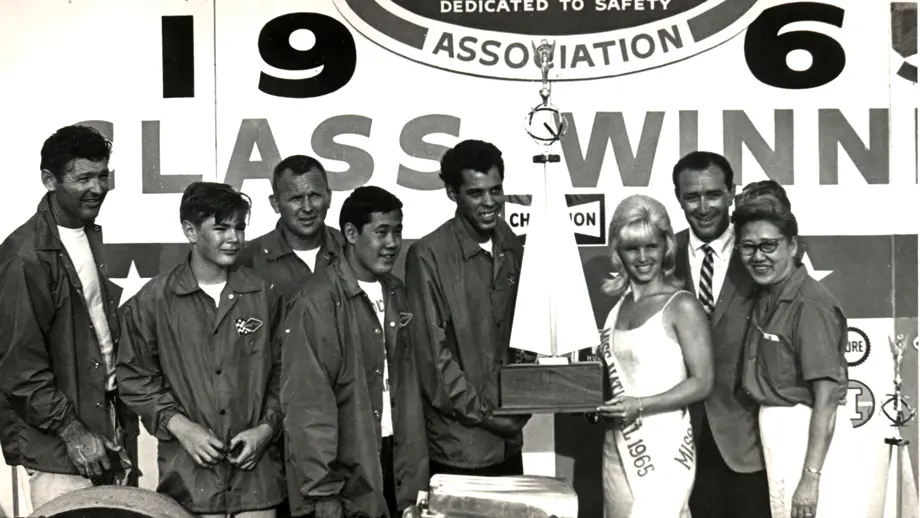
The 65th annual Chevrolet Performance U.S. Nationals is coming up, and promises to be a celebration of the event’s long and rich history. In the months leading up the event, I’ll chronicle some of the great stories that made Indy the world’s biggest and most important drag racing event.
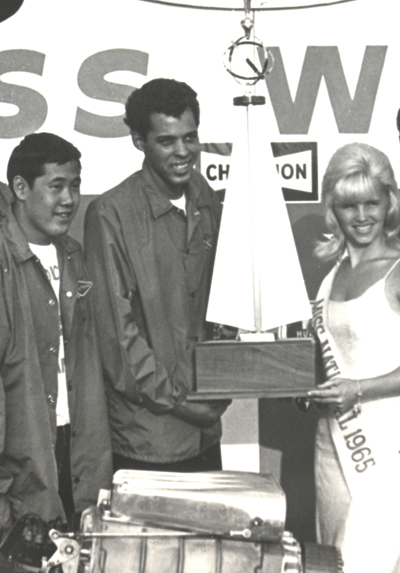
When they won the 1965 U.S. Nationals, Don Prudhomme and Roland Leong made NHRA history by becoming the first Top Fuel team to win more than one race in an NHRA national event season. The duo, whose friendship was less than a year old and whose partnership on the Hawaiian dragster was even newer, had won the Winternationals in their California backyards to kick off NHRA’s four-event season -– which also included the Springnationals in Bristol, Tenn., and the World Finals in Tulsa, Okla. –- then headed east for fame and fortune.
Their long journey east would be filled with new adventures and experiences, unprecedented success, and more than a few setbacks as they criss-crossed the Midwest and East Coast before finally arriving in Indy for the Nationals.
That the two were together and on the path to the glory that would not only perpetually nourish their respective budding careers was one of those serendipitous sojourns that is so far-fetched that you have to believe it was written in the stars.
:: FAST FRIENDS ::
Leong was young, less than 20 years old but an ambitious gas dragster driver and a mild celebrity on the islands when he left his native Hawaii to come to drag racing’s Promised Land, California, in the early 1960s. He got work at the famed Dragmasters chassis building emporium near San Diego, but often got homesick while trying to carve his place and it was on one of his returns home where he first met Prudhomme in 1964.
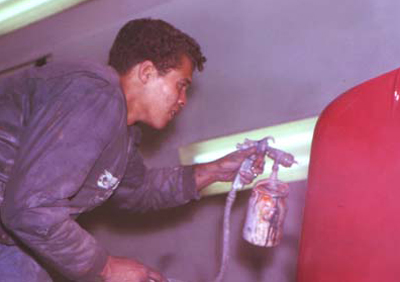
Prudhomme was born to be a drag racer. He may have painted cars at his dad’s auto body shop to make a living but he was a standout driver. In 1964, he was in his third year driving one of the era’s most dominant cars, the Greer-Black-Prudhomme dragster financed by Tommy Greer, tuned by engine maestro Keith Black, and driven by the kid from the San Fernando Valley. Prudhomme had learned at the knee of the best, with fellow Burbank Road Kings car club member Tommy Ivo and with highly respected tuner Dave Zeuschel.
Although the G-B-P monster never really racked up the mythological 236-7 record touted in a hyperbolic Schiefer Clutches ad in the May 18, 1963 issue of Drag News and repeated as fact for years (the authoritative Top Fuel Handbook pegs it at 81-8, still incredibly impressive), it still was the West Coast’s best car and gave “the Snake” a thirst for winning.
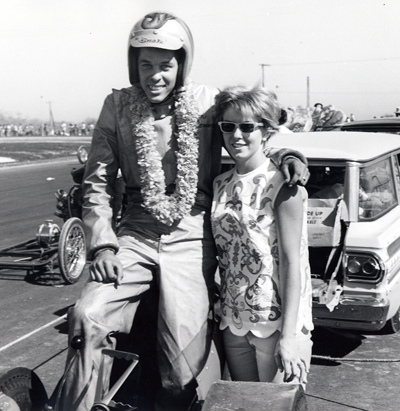
Black, whose engines were becoming widely used, took the car to Hawaii for a promotional trip to visit some of his customers, including the Leongs, and it was there that Prudhomme, accompanied by his wife, Lynn, and Leong first met and quickly bonded.
They were an odd couple for sure, Leong, the son of well-off parents James and Teddy, who owned an insurance agency and a stake in a local hot rod shop where Roland worked, and Prudhomme already the savvy and battle-tested veteran of street and strip wars at age 23 from the land of chrome and metalflake. But they clicked right away.
“I guess I always wanted a little brother,” Prudhomme -- a kid brother himself to Monette (who passed away in 1975) -- half-joked when I asked about this. “He was just like me. All we cared about was drag racing and cars. Even though I had a lot more experience than him, I really felt like we were equals. I think he looked up to me a little more than I realized at the time, but it wasn’t like I was the boss or anything.”
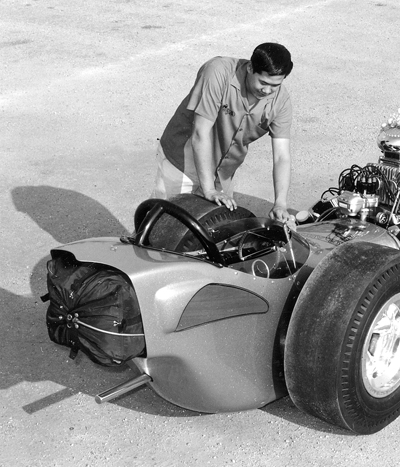
Leong had long coveted the idea of running a Top Fueler and, according to his memory (and there are conflicting versions from others), he had already commissioned Kent Fuller to build him a dragster like the G-B-P car, only longer, well before Prudhomme and Co. arrived.
As the well-told story goes, Leong’s career as a fuel-dragster pilot ended on his first pass on Aug. 4, 1964, at Lions Dragstrip. At the conclusion of an 8.01 pass at 191.48 mph, Leong lost the handle and crashed. Leong has said that, unfamiliar with the process, he accidentally had mixed too stiff a percentage of nitro and, going way too fast and being unfamiliar with the cockpit layout of his new car, missed the parachute handle, bumped the steering wheel with his elbow, and ended up going off the end of the track.
Black went white as a ghost, knew he could never tell Momma Teddy that he’d let her son get killed, and told Leong he needed to find a driver. And Black knew just the one. Greer's industrial machine business had taken a downturn, and he had sold the Greer-Black-Prudhomme car to Black for what he owed him in winnings and wages. Black’s engine business was ramping up and he didn’t want to run the car anymore, so Prudhomme was available and Black played matchmaker.
As Leong told me the other day, “ ‘Snake’ quit his job painting cars and that was the last time he ever worked. I tease him and tell him, ‘Hey sucker, you’re lucky I wasn’t worth a sh*t as a driver or you might still be painting cars.”
:: WEST COAST KILLERS ::
As soon as the Hawaiian was repaired, Prudhomme took some passes in the car at the end of 1964 and they turned their attention to 1965, which just so happened to be “The Year of the Snake” in the 12-year cycle of Chinese zodiac calendars. Go figure.
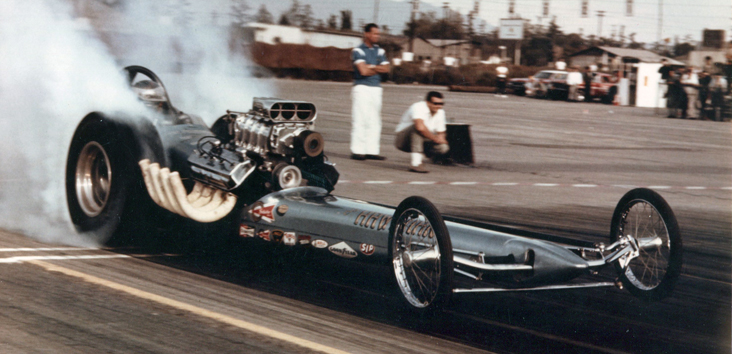
Poring over the pages of National Dragster, I can find that Leong and Prudhomme ran the car at least once before the 1965 Winternationals, on Jan. 17 at Pomona Raceway (which held regular Top Fuel shows outside of the national event), where Prudhomme overstaged against the Frantic Four entry and fouled to “Stormin’ Norman" Weekly. Press materials from the Hawaiian camp also cite two Southern California wins, which I’m going to surmise were at Lions, which was not under NHRA sanction and thus not eligible to have its reports in ND. I do know that the team reset the Lions speed record at 204 mph early in January.
They went to the Winternationals and kicked some major ass, defeating Bill Alexander in the final round [read the full National Dragster recap here] and the floodgates opened with booking requests not only up and down the West Coast, but back east, too.
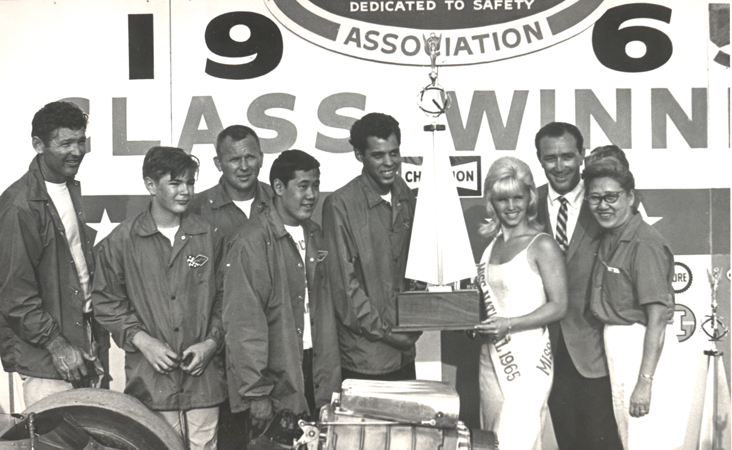
“Winning Pomona was like having a hit record,” recalled Prudhomme. “After that, you could get all kinds of bookings. Tracks would compete against one another to get you; you could raise your prices and make some pretty good money. And with the car’s exotic name –- ‘the Hawaiian’ -– and being from Hawaii, there was a lot of interest in the car for that alone. And when you’re from California, which seems like a long way away for people on the East Coast, and there’s this reputation of chrome and candy-apple paint and the zoomy Tom Hanna bodies,. People were interested in seeing that.
“We started getting calls from places like York, Pa., and Cecil County, Md., wanting the Hawaiian to come run there. For the most part they’d call Keith’s shop and ask for Roland or me. But, to be honest, until then, running Indy never even crossed my mind. You have to remember that it wasn’t until 1964 that the nitro ban had ended and they started running fuel cars again at Indy, so for guys like me who ran fuel dragsters, we had never really had given Indy much thought.”
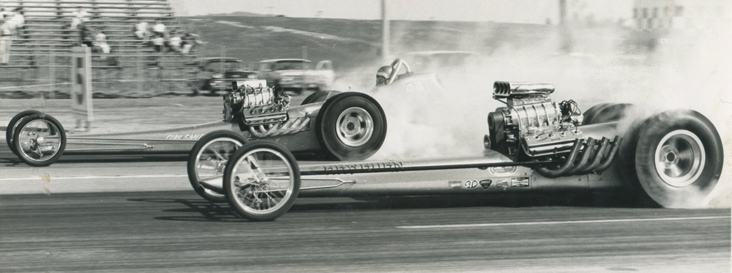
In the months after their Winternationals triumph, the boys stayed in California, running the March Meet on March 7 (where Prudhomme suffered a stinging second-round loss to his mentor, Ivo); Riverside Raceway on March 21, where he lost by inches to Larry Faust and the Mooneyham-Ferguson-Faust machine in the semifinals (pictured above); and Pomona again in March 28, where he got beat by future NHRA Chief Starter Rick “the Ice Man” Stewart and the Adams & Stewart car. There’s an NHRA gap –- no doubt with some Lions dates -- until they showed up in Pomona again April 25 and won the show, beating Bill Leavitt, 7.85 to 7.98, to claim the $700 bounty.
They then traveled north, winning $1,320 (“a clam a foot," it was advertised) on May 9 at the Santa Maria Dragons event in central California, beating a field that included James Warren driving two cars (Warren & Coburn and Warren & Crow), 1964 Winternationals champ Jack Williams in the Crossley-Williams entry, and future Hawaiian pilot Mike Sniveley in Ed Pink’s “Old Master,” running a sizzling 7.65 in the final to beat Nando Haase in the Radar Wheel Special.
Two weeks later, on May 23, they were at Half Moon Bay Drag Strip (“the Pebble Beach of Drag Racing”) for the California State championships and defeated an eight-car field that included the likes of local favorites Ted Gotelli and Gary Ormsby and beat Kenny Safford in the B&M Torkmaster car (which Prudhomme would take over in 1966) when Safford’s mount lost fire, handing the $1,000 win to the Hawaiian.
They went back south and the last SoCal report I can find is June 20 for the big Hot Rod Magazine Championships. They qualified somewhere in top eight of the 32-car field but are not mentioned again in ND’s scattergun coverage so I’m gonna assume they lost in round one.
It was at this point that the team decided it was time to head east.
:: GOING ON TOUR ::

Even though they didn’t leave town until late June (at best), a month after Leong’s 21st birthday, the tour had been announced in the April 2 issue of National Dragster, showing that the idea had been planted well before the spring.
Recalls Leong, “After [the West Coast tracks] had seen us once or twice they weren’t going to keep paying us, and I was thinking, ‘What are going to do all summer? Let’s go back east and race the big guys.' ”
Prudhomme said virtually the same thing –- right down to “the big guys” -- which I find inordinately interesting considering that the West Coast had some pretty stout cars of its own yet they still had a bit of an inferiority complex when it came to guys like Don Garlits, Chris Karamesines, Connie Kalitta, et al.
The other question mark would be the absence of their maestro, Black, who just couldn’t go on the road with them due to his burgeoning business, and both Leong and Prudhomme had their concerns.
Recalls Leong, “When we left California to go on tour, I think a lot of the top Fuel teams were thinking, ‘Well, we’ll see how they do out on the road with no Keith Black.’ Prudhomme had a lot more experience in Top Fuel but he never ran the car."
“I wasn’t an engine guy,” Prudhomme admitted. “I was just the driver. Sure, we had some doubts. We really felt like to make it, you had to win back east. Winning in your backyard, where you knew the tracks and the weather, was one thing, but to go somewhere where there was humidity and heat and wind and new tracks and guys you might not have raced before was a big deal.”
:: GETTING READY ::
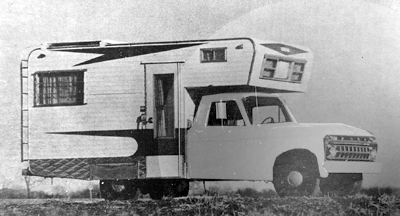
Part of their bounty for winning the Winternationals was a Ford F250 pickup truck with a Dreamer camper strapped to its back. It had beds inside and was “fully equipped with a built-in oven and range and ice box”; it seemed like the perfect prize for a couple of guys about to go on a road trip. Heck, it even had its own toilet.
“Had” being the operative word here. It was quickly removed, not for weight considerations or space, but for more practical "guy" reasons.
“We took the toilet out because neither of us figured we were going to clean it; if it wasn’t there, no one could use it, right?” reasoned Leong.
They also won a Ford SOHC fuel engine, but because Black was a staunch Chrysler guy, they opted to take the cash equivalent instead; more money for the road trip.
Traveling up and down the West Coast, where every track was a day’s drive and the weather was generally good, afforded them the luxury of having an open trailer. Heading back east on a multi-month, weather-questionable sojourn was another, so they commissioned Rod Peppmuller, another Burbank Road King who built Ivo’s chassis, to weld them up a frame for an enclosed trailer. Prudhomme’s neighbor, a fireman, was handy with tools, so they used plywood to build a box to contain the car and the spare engine they’d need to carry.
“We made it out made of wood, like Noah’s Ark,” Prudhomme reminisced. “It was heavy because no one knew about building trailers back then. We were forever blowing out tires because we were overweight; it was all trial and error.”
The truck/camper also proved problematic almost from the start.
“It was a pain in the ass because it was so big when we’d try to turn the trailer around in the pits or push-start the car,” recalled Leong. “Plus the truck only had one gas tank that held maybe 18 gallons. We spent more time in the gas stations than we did on the road. We were young and dumb; we didn’t know any of that [stuff].
"After a few months, a guy in Chicago wanted to buy the camper; I said ‘[Screw] it,’ and sold it right on the spot and drove down to Mr. Norm and bought a Dodge wagon.” [Mr. Norm being Norm Kraus, who owned the Grand Spaulding Dodge dealership, located at the corner of Grand and Spaulding Avenues in the Humboldt Park area on the west side of Chicago; Kraus had a state-of-the-art shop, with a chassis dyno, and a multi-car race team.]
:: ROAD WARRIORS ::
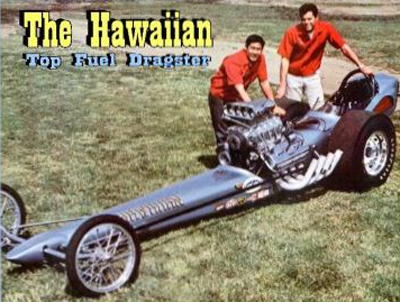
Prudhomme, whose six months on the road touring with Ivo in 1960 was pretty much all the experience he and Leong had when they headed out. (Leong had been to Indy in 1963, with fellow (and older) Hawaiian Danny Ongais, whom Teddy had sent along to safeguard her baby.)
The boys set out with little more than a collection of road maps and a vague idea what to do along the way. “Hey, when you wanted to do something as bad as we wanted to do this, we’d have pushed the car by hand across the country if we had to,” testified Prudhomme. “It was the best time of our lives.”
Prudhomme had done all of the bookings, and they were pretty varied. Even with a full library of ND issues and indispensable help from drag racing historian laureate Dave Wallace and his collection of Drag News, and a few match-race contracts supplied by Lynn Prudhomme, I couldn’t track every step of the way, but I think we got close.
Leong remembers very well their first “road date,” at Rockford Dragway in Illinois, where they were booked to run against a jet dragster, a fairly common thing in those days. According to Drag News, on July 11 Prudhomme beat Roger "Lucky" Harris in Art Malone's "U.S. 1" jet in two straight and set the track e.t. record of 7.48 in the first round (at 209.30 mph) then broke Chris Karamesines' week-old 210.52 speed record with second-round 213.07 mph. The e.t. on the speed record was lost after a two-foot wheelie and rear-wheel start of the e.t. clock produced a literally-unbelievable 6.975 clocking. (Harris' "luck" would run out a year later when he was killed in the car June 3, 1966, at Islip Speedway in New York.)
“I had never even seen a jet car, let alone raced one,” Leong admitted. “I was scared to death seeing that car on the starting line, belching fire and making all of this racket. I was no nervous I didn’t even get out of the truck the first run. I just pulled up next to Prudhomme and waved him forward. Fortunately Rockford was a really wide track -– one of the first to run four-wide.”
In July (no date listed), the Hawaiian also beat Ron Goodsell for the Frantic Four in a match race at Motor City Dragway in Detroit, where "the Snake" ran 7.50 to set a new track record and a July 25 date at Alton Dragway.
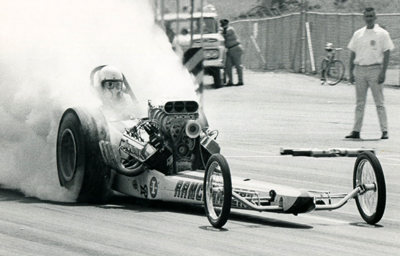
Although we couldn't find any record of action in either publication between mid-July and early August, the team continued its eastward route to Capitol Raceway near Washington, D.C., for an Aug. 8 date with Don Westerdale for the Ramchargers and a rare loss. Westerdale set track records of 7.44 and 205.00 in first round after Snake fouled and shut off, but Prudhomme rebounded in round two to win "by inches" over Westerdale in which Prudhomme was credited with another obviously-bogus wheelstand-initiated 6.94. Westerdale then wrapped up the match with a third-round win. Why were the Ramchagers so tough? As Wallace reminded me, the Ramchargers, who were essentially the Dodge factory team, were nearly single-handedly developing the still-new 426 for blown fuel while Black stuck with the tried-and-true early 392 Hemi last manufactured in 1959.
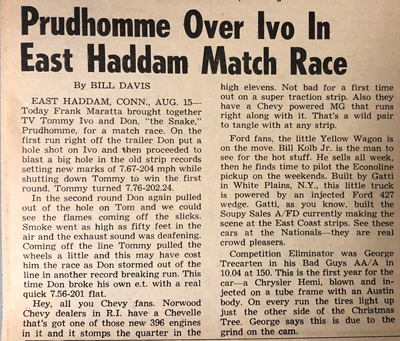
On Aug. 14, the Hawaiian won a three-round match at New Jersey's Atco Dragway over Ivo, capped by "the Snake's" match-best 7.93 in the final over Ivo, whose wild ride was described in coverage as going "through the eyes on a 45-degree angle." Ivo and Prudhomme dueled the following day at Connecticut Int’l Raceway with Prudhomme beating Ivo in two straight with a best pass of 7.45 at 204 mph.
From there it was an Aug. 21 date at York U.S. 30 Drag-o-way in Pennsylvania for a date that I know of only because of the contract from Lynn. No record could be found in either of the drag weeklies.
Even without any printed confirmation due to gaps in the results coverage (according to Wallace, "This is not unusual, considering that the the vast majority of drag strips did NOT submit event coverage to the paper regularly, if ever."), I wholeheartedly accept Prudhomme's and Leong's separate but matching claim of a 90-percent win rate on the trip.
:: CONTRACT LABOR ::
As I mentioned previously in this article, Lynn Prudhomme, eager to help me flesh out the schedule, sent me a trio of contracts that her husband had signed for match-race dates in 1965. These were the binding agreements between the racetrack operator and the race teams that laid out the date, run requirements, payment, and non-compete clauses that laid the groundwork for the match-race scene.

Alton Dragway's contract for the July 25 date, signed by Ray Walker, called for "exhibition runs or competition runs against an opponent chosen by the Alton Dragway" for the tidy sum of $1,000 and a generous $500 "appearance" fee in case of rainout. The contract also goes on to stipulate that, in case of mechanical trouble, the payment will be based on "the number of runs in proportion to the number required." For A/FX, S/S, and S/SA car that number was five. Gas cars, including dragsters, were required to make four, and fuel cars had to make three runs.
The Capitol Raceway contract for the August match with the Ramchargers, signed by track manager Julio Marra on June 23, agreed to pay "Don Phurdome" (apparently not yet a household name in Maryland) $500 to run the best-of-three match race. The rainout provision was for $200.
York's contract was far and away the most expansive of the three samples. Signed by Prudhomme on May 5 before they headed out, it agreed to pay $750 for three runs with a $375 rainout "appearance" fee and requires that, "The exhibitor agrees to make his required runs to the best of his ability and at times designated by the strip manager."
It later goes on to explicitly state (in all capital letters) that the exhibitor "must agree not to appear within a 100-mile radius (air miles) during the months of July and August, except for Atco Drag-O-Way in New Jersey" before the appearance at York.
It also goes on to helpfully add, "For extra dates, we suggest you try the Midwest or New England states."
:: THE ISLIP INCIDENT ::
Mid-August found the boys in New York for a week that began with a yet another match race with Ivo, this time at eighth-mile Islip Speedway. The Islip date was not found in either National Dragster or Drag News, but fortunately was memorialized in Bruce Newman’s in-depth essay on Prudhomme in the Dec. 6, 1976 issue of Sports Illustrated in an article headlined “This Snake Doesn't Rattle, He Rolls.” At about 6,000 words, it’s an amazing amount of space devoted by SI to drag racing (by comparison, this column, one of the longest I've ever written, is about 7,000 words, but it's on the web, not in print). You can find the entire Newman article here; it’s a very good read.
Here's the Islip portion:
In addition to being half the length of a normal drag strip, it had a shutdown area that was a holy mess. Ivo and Prudhomme agreed before the first of their three match races that they would ease off the throttle early and not risk crashing. Moreover, Ivo insisted that since he had arranged the booking and had the larger following, he should be allowed to win the races. Prudhomme agreed, reluctantly, but when the moment came for him to let Ivo beat him, he couldn't do it.
Between runs Ivo reminded Prudhomme of their bargain, and the Snake dutifully promised to throw the next two races. But when Ivo won the second heat, one of Prudhomme's crewmen couldn't resist putting the needle in. "See, Prudhomme, Ivo can beat you any time he wants to," he said. What Prudhomme said is not a matter for the record, but it is safe to say that he came to the starting line for the third race with a flinty look in his eyes and a firm resolve to win.
Ivo, however, came to the line with something even better — the sure and certain knowledge that the starter was going to hit the green light the instant the front wheels of both cars had broken the electric eye's beam of light, rather than holding them for an instant, as is customary. Ivo, as it happened, had spoken to the starter, and assured him that this was just as Prudhomme wanted it. By the time Prudhomme realized what was happening, Ivo was long gone. Extremely long, as it turned out. Ivo's braking parachute failed to open, so when Prudhomme finally caught up with him, they were past the end of the track and in the parking lot. Prudhomme was so moved by Ivo's perfidy that it took several crewmen to prevent him from decking TV Tommy.
I immediately had problems with the narrative of this story; the Prudhomme that I have known for decades –- Mr. “Rip Their Throats Out” -- would never agree to let someone else win. Or would he?
Well, “the Snake” confirmed to me it 'twas actually true, and the confusion that reigned was because only he and Ivo knew about the arrangement.
“That was the one and only time I agreed to let someone beat me because we needed the money, but it wasn’t worth it," he explained. "It turned into a big fight and hard feelings. Ivo’s crewmember was ‘Tarzan’ [the notoriously tough and freewheeling John Austin]. ‘Tarzan’ did not know that we had it arranged for [Ivo] to win, and when he came down the track he was honking the horn and laughing that they blew us off. I got pissed off and said ‘[Screw] you, we're racing for it now.' ‘Tarzan’ was thinking that they beat us there and square so it turned into a big hassle. I didn’t even tell Roland what the deal was, so he was in shock.”
Prudhomme would soon have his revenge on Ivo and Austin.
:: SEEING SITES (OR NOT) ::
Prudhomme always couldn’t wait to get to the next track -- he didn’t care to see the World’s Biggest Ball of Twine along the way -– but they did take a couple of days off in New York after running in Islip to visit the 1964 World's Fair (the fair ran for two six-month seasons, April 22–Oct. 18, 1964, and April 21– Oct. 17, 1965) at Flushing Meadows–Corona Park in Queens. Admission was $2.50, equivalent to about $20 today.
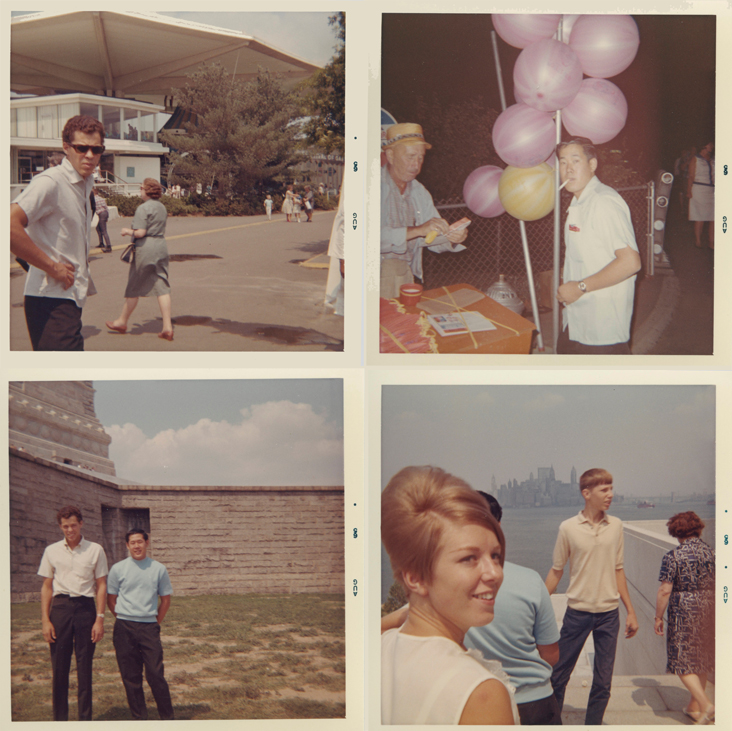
Lynn, who occasionally met up with the boys on tour, sent me these amazing photos from the Fair and also what appears to be the Statue of Liberty. Prudhomme also remembers they went to see the play Funny Girl on Broadway, featuring a young Barbra Streisand in the lead role, and Lynn told me they also saw Oliver. It was the first plays that either had seen. Leong and Ivo palled around, too, in the evenings, and also saw Oliver.
From New York they headed back east and stopped at Great Lakes Dragaway in Union Grove, Wis., on Aug. 28-29 , their final stop before hitting Indy. Great Lakes was another romp over Ivo, as the Hawaiian cut a best of 7.65 at a reported 215 mph while Ivo could muster no better than an 8.29 at just 204 mph. The Hawaiian, which according to an Engle Cams ads in Drag News ran the same 392 block throughout the eastern tour, suffered rare breakage on its final pass in the form of a broken roller lifter, according to Leong.
The team quickly loaded up for the 250-mile trek down Interstate 65 to Indy for the Nationals, which were run on Sept. 2-6, and reunited Leong and Prudhomme with Keith Black, who flew in from California, along with Lynn.
:: BACK IN BLACK ::

“Having Keith come to Indy was huge for us,” said Prudhomme. “He was kind of like a father to both of us. He was always in control and just so good with the engine. He was always calm.
“On the road, Roland was tuning the car the whole time and my contribution was ‘Yeah, the engine sounds good’ or ‘It doesn’t sound good’ and maybe we’d mess with the barrel valve, but there was very little adjusting. It was a very simple engine; they all were. And the good thing is that the thing never broke. Between the barrel valve, the fuel pump, and the clutch, those were the only thing you messed with. They just ran. You’d drain the oil and check the bearings; we didn’t even have to run the valves, let alone take the heads off like they do today.
“Roland actually ran the engine harder that Keith did; Roland always wanted to set low e.t. and top speed. Keith used to get mad at him for running it that hard.”
(Leong remembers the notoriously competitive Prudhomme once telling the steady yet conservative Black, “I’d rather blow the [expletive] engine out of the chassis than lose a race,” and Black responding, “Well buddy, you’re driving for the wrong person.”)
Leong also caught hell from Black at Indy for not field-stripping the engine to look for damage after the lifter failure.,
“Instead of taking the motor all apart after Union Grove, I just cleaned it out ,” said Leong. “When we got to Indy and Keith showed up, he said, ‘Let me check the bearings’ and he found there were still some needle bearings from the roller. He about had a heart attack. He was pretty mad.”
:: INDY, FINALLY ::
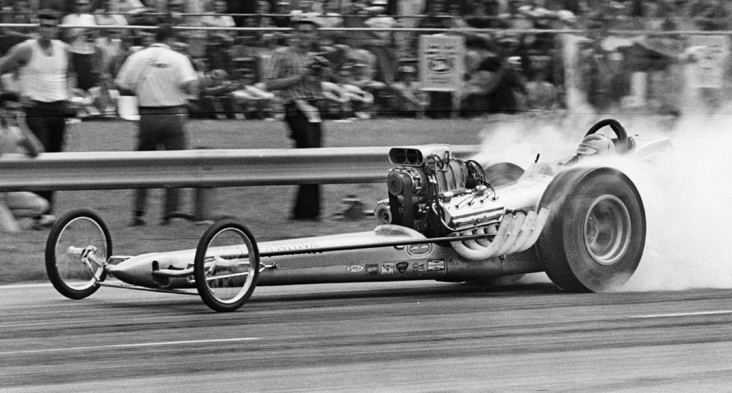
That “ol’ Black magic” was evident from the start. Prudhomme’s opening lap Thursday in Indy was a 7.65, which tied Kalitta for low e.t. of the day but was surpassed by Westerdale’s blistering 7.509 in the Ramchargers rail Friday, not far off the 7.47 national record he had set in July in York, Pa. His 210.70-mph clocking stood as Top Speed of the Meet and his e.t. held up for through Saturday for the No. 1 spot.
Sunday was reserved for AA/FD class eliminations, which earned the winner the privilege (some might say “burden”) of sitting out Monday’s 16-car eliminator, then racing the winner of that field for the overall title.
The Hawaiian went five rounds Sunday to win class, breezing past Larry Posluszny with a 7.81 then upsetting Westerdale, 7.68 to 7.74. In the third round, Prudhomme eliminated 1963 Indy winner Bobby Vodnik (who, in a rematch of their ’63 final, had beaten Garlits in round one), pacing the Hawaiian to a better-still 7.63. Prudhomme then defeated Leong’s pal Ongais and the powerful West Coast-based Broussard-Davis-Ongais "Mangler" with a 7.59 in the semifinals.
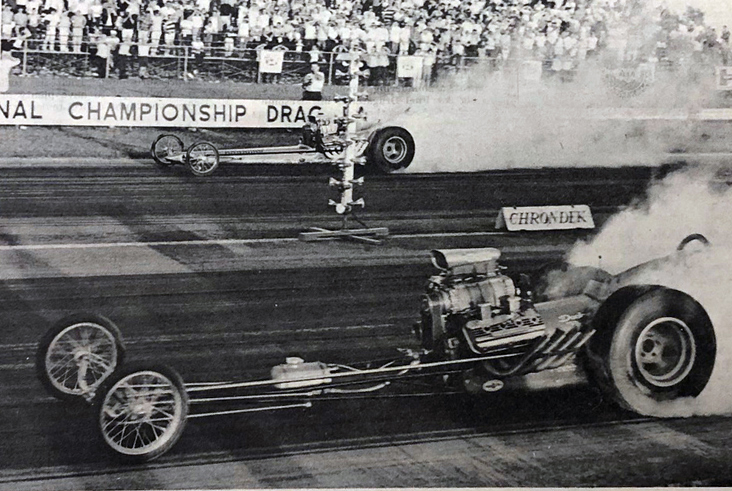
The AA/FD class final, against “the Smilin’ Okie,” Jimmy Nix, was over before it started as Nix fouled -- as is clear in the photo above -- but Prudhomme made doubly sure with a stout 7.60 to earn the “sit out” position Monday.
As fate would have, it was their recent nemesis and occasional touring partner Ivo, who waded through four rounds on Monday, beating Nando Haase on a 7.90 to 7.82 holeshot in round one, a centerline-flirting Maynard Rupp with a 7.67 in round two, a red-lighting Jim Dunn in the semifinals, and a wire-to-wire 7.68 win over Tom Hoover in the final for the right to face his protégé and the former recipient of many of Ivo’s pranks on that 1960 tour (such as replacing the shampoo in their hotel room with motor oil).

On face of it, the whole “sit out” procedure seemed to heavily penalize the sitter-outer. While Sunday’s winner sat on the sidelines all Monday with a day-old combination, the Monday winner came into the final shootout with four laps on a surface and in weather that may have changed greatly since Sunday evening. Prudhomme’s average e.t. in winning class was 7.66 (combined opponent average was 7.85) while Ivo had average a 7.75 on Monday, but had fresher “data.”
“We must have smoked five packs of cigarettes between Roland and myself stressing about making one run for the win,” Prudhomme allowed. “And then for it to be Ivo, of all people, a couple of California guys ending up in the final in Indy and everything that happened in Islip. It was a lot of pressure.
“How bad did I want to win? Brutally bad. The good thing for me was that Roland and I kept each other normalized. We were so close it was scary. He always knew what I was thinking and I always knew what he was thinking. When we went to race Ivo I knew that I had his support, and that win, lose, or draw we were in it together.”

Black wanted it pretty bad, too. The tune-up he put in the car carried Prudhomme to a 7.504 – five-thousandths quicker than Westerdale’s No. 1-qualifying/Low E.T. pass -– and Prudhomme’s holeshot on Ivo only furthered the distance between him and Ivo’s 7.81.
:: IVO'S VERSION ::
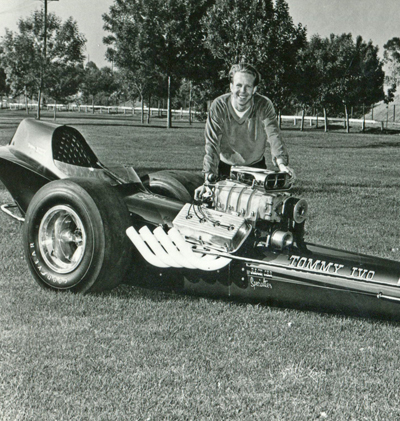
I dropped Ivo an email to ask for his thoughts on the outcome, and “Your hero and mine” (as he always signs his communiques) replied quickly with a lot of interesting revelations about the meet, beginning with the fact that a) He had never run Indy before and only came this year to thank Wally Parks for taking him and Garlits to England the year before; and b) didn’t even initially qualify for Monday’s race (unlike today, where we publish full qualifying and alternates for each event, that was not part of ND reportage in 1965) and only got in as an alternate after using his "T.V. Tommy" Hollywood acting skills to good effect.
“I had three (count ‘em folks), three bad magnetos and ended up third alternate for the race,” Ivo wrote. “But I noticed one of the last guys to qualify exploded everything from the front axle to the parachute BIG TIME, sooooo I tip- toed over to his pit and asked him if he was going to be able to get it back together for the race. And ‘voila,’ he said No! A glimmer of hope started to raise above the horizon.
"Sooooo, off to the first alternate's camp I went and started complaining to him, that with only being an alternate. I wasn't going to stick around to watch the race in all that heat and then have to drive all night to get home to my base in Chicago to which he agreed, that he thinks he'd had enough and was going to leave as well and fell for my smooth-talking, hook, line and sinker and started packing up the car to go. Obviously he didn't know what I knew about the big explosion of one of the 16 qualifiers.
“Shazam, I was off to the second alternate to give him the same song and dance, with a little, ‘no light at the end of the tunnel’ twist and down he went, the lure in his mouth, hook, line, and sinker. TA-DA! I was in!!”
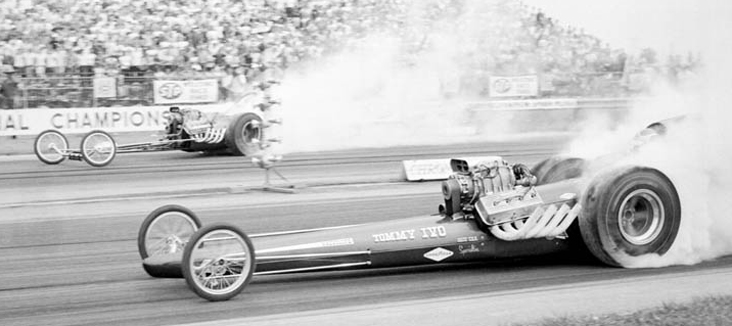
Ivo also kept assuring himself a spot in the favored left lane throughout Monday eliminations (pictured above racing Maynard Rupp) by servicing the car between rounds in the staging lane that led to the left lane, having stocked all of his stuff in the huge trunk of his Cadillac pushcar. This was before the lower-e.t.-gets-lane-choice rule and you ran in the lane you got yourself into.
Unfortunately for Ivo, Prudhomme, Leong, and Black, were too savvy to fall for that trick in the final.
“As I was pushing out for the last round of the Monday race, I saw the whole Hawaiian bunch hula dancing their up in the left staging lane, so close to the fence they were scraping the paint on the push car on it,” Ivo recalled. “None of them were born yesterday and the whole motley pack of them knew which side of the track was greasy."
Ivo also put a fresh perspective on the advantage for the sit-out car.
“When I limped back to the staging lanes, after winning the last round of the Monday race, which now made it a five-round race, [it was] against a fresh car from the day before and I'd sacrificed a piston on the round before for the win," he asserted. "In those days you didn't change pistons in a steel-blocked dragster, but just tie rags around the rocker cover breathers and hope for the best.
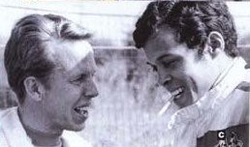
“So up to ‘the Snake’ I trotted with a coin cocked in my finger and said, ‘Do you want heads to tails?’ to which he disagreed with a hiss and said ‘We're in the left lane.’ I told him we always flip for lanes, which we'd been doing all summer long at the match races, and flipped the coin in the air. By instinct and forced not to think before he spoke, he called tails. Ye Gods, it was tails. I often wondered if World War III would have erupted in the staging lanes if it had come up heads. But alas, he won the toss and the race -- and now you know the rest of the story. Tear, tear, tear.”
Ivo never did win Indy, but knows he only has himself to blame.
"I went every year after that, but Labor Day was a four-race weekend, for a BIG payday for match racing," he explained. "After qualifying on Thursday at Indy, I would run off and do Friday, Saturday, and a Sunday match racing. and then come back for the actual race itself on Monday. Which was really no way to try to win Indy."
:: HISTORIC VICTORY ::
The Indy victory made Prudhomme just the fourth driver in NHRA history with more than one national event win and the only one to do it burning nitro. Only “Ohio George” Montgomery (three) and Jack Chrisman and Hugh Tucker (two apiece) had won more than once -– granted, the 1965 Nationals was only the 17th national event in NHRA history –- but Prudhomme was the first to win more than once in a season. Top Stock racer Jere Stahl would win three times in 1966 and Leong’s new driver, Mike Sniveley, would also win the Winternationals and Nationals in 1966, but Prudhomme will always be the first.
“Winning two national events in the same year was a big deal,” he admits. “It really put us on the map. Although I hadn’t put a lot of stock into winning Indy earlier that year, now I look back on it and know that winning Indy is like winning the Super Bowl; you can have a great regular season but if you don’t win the Super Bowl, it doesn’t mean sh*t, right? But, in all honesty, winning the Winternationals and Indy really made both of our careers.”

The duo’s winnings were significant and, like in Pomona, the bounty also included a vehicle, in this case a new 1965 Plymouth Barracuda (pictured below). This time, however, like they did with the Ford engine in Pomona, they chose to take the cash. The photo at right, showing NHRA President Wally Parks handing over a set of keys to Prudhomme while Roland and Teddy Leong beam brightly on either side, was purely symbolic. (“I wish we had taken the car,” Prudhomme laments today. “Do you know what that thing would be worth?”)
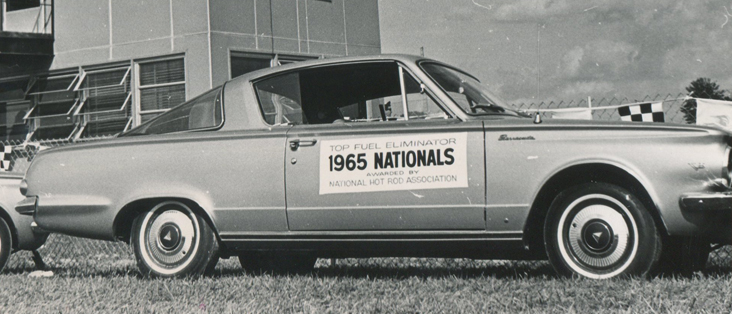
:: VICTORY, DISILLUSIONMENT, AND NEAR DISASTER ::
Their Indy success paid other immediate dividends as Gil Kohn, who owned Detroit Dragway, had a big race coming up that Wednesday and offered them appearance money to race. They were already scheduled to run that next weekend on Salem, Ohio, but agreed to take the detour to Detroit.
“It was a big race, with Garlits, the Ramchargers, everyone, “ recalls Leong, “but we were the only ones who got paid. Then we went there and won that race, too.”
The next weekend, Sept. 10-12, was a big NASCAR-sanctioned event at Dragway 42 in Ohio that got rained out, but not before Prudhomme claimed a $1,000 bounty for qualifying No. 1 with a 7.60 at 202.70. The homesick duo took a flight home to California and then returned for the resumption, where they again reached the final against Westerdale and the mighty Ramchargers machine.
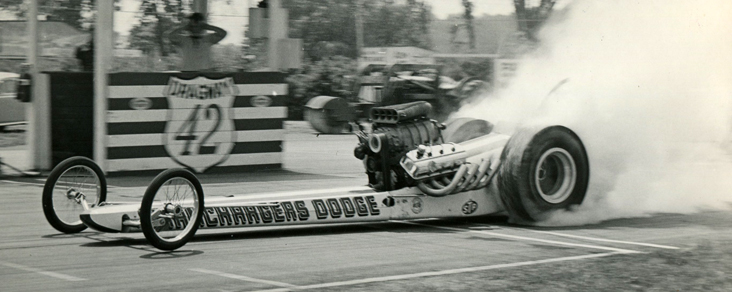
By all accounts, Prudhomme won that race, too, running 7.59 to Westerdale’s 7.70 and you know that “the Snake” wasn’t going to be late, but the win light came on in Westerdale’s lane. Some witnesses at the top end told Leong that the Hawaiian had carried the front wheels over the finish-line beams while clearly ahead. Their protests were met by deaf ears of officials.
“We were so mad, loaded up our sh*t and headed straight home to L.A.,” said Leong.
The glum chums were on the westbound turnpike somewhere in the middle of Oklahoma, with Leong taking a rare turn behind the wheel of the wagon at around 2 a.m., when disaster nearly struck.
“I usually wouldn’t let him drive, but I got so tired I let him,” remembers Prudhomme. “When I woke up, he was in the left-hand lane passing a truck. He said, ‘Hey, Vipe, I think I got this driving thing down now.’ Just when he said that, he got sucked into the truck, lost it, and spun us out. Neither of us got hurt, but we ended up in the middle of the highway with stuff all spread out, Pennzoil cans all over the highway and everything."
Added Leong, "When you're passing a truck, it will suck you in, so you’re supposed to hold onto the trailer brake –- kind of like having a parachute to keep you straight –- then you’d let go of the brake and off you go. For whatever reason it didn’t work this time. We were going down a hill and I just jack-knifed it. ‘Snake’ didn’t let me drive the rest of the way.”
The wagon ended up with a hole in the gas tank, but they were able to get the wounded unit towed to Nix’s home, where repairs were made and off they went.
(Things got worse for Leong the next year, with new driver Mike Snively, on their way from California to Amarillo, Texas. Leong was asleep in the back of their station wagon when another racer, driving a ’57 Chevy and pulling another ’57 Chevy, tried to pass them on a two-lane road and lost control and swerved back into them, sending both rigs off the road and upside down.)
Prudhomme and Leong made it safely home in 1965, finished up the racing season together, then split up as Prudhomme decided it was time to become an owner/driver and full-time professional racer. The reason was obvious.
:: GOING SEPARATE WAYS ::
Lynn Prudhomme shared with me Don’s 1965 tax return. As a “spray painter” at Holiday Auto Body in Sherman Oaks, Calif., Prudhomme made $4,116.66. As a “Drag racing driver” he grossed $11,650 and, after expenses (including “86 days of meals and lodging at $7 @ day,” laundry, and phone bills), pocketed $9409.05 -– more than double his painting job and doing what he loved.
“Making $4,000 painting cars was a lot of money to me back then, but $11,000? Oh my God; I had no idea someone could make that much money racing,” he reflected.
So off they went their own separate ways, both to go on to fabulous careers with more Indy wins and glory than either could have dreamed. The two, who were reunited several times -- Leong being there for Prudhomme's "I think I'm gonna quit" moment at the 1970 Nationals and later hired by Prudhomme as a crew chief on his Ron Capps-driven Funny Car in the 2000s -- remain close friends, a bond forged in the fire of a season on the road in 1965 that set the plate for their careers and their life roads ahead.
Phil Burgess can reached at pburgess@nhra.com
Hundreds of more articles like this can be found in the DRAGSTER INSIDER COLUMN ARCHIVE



















































